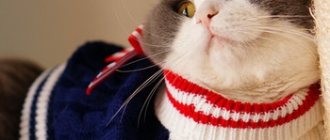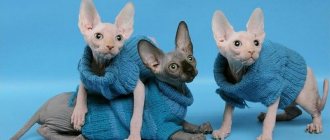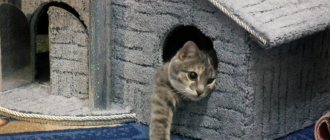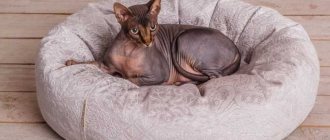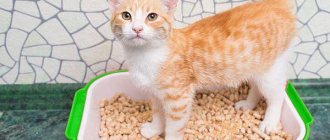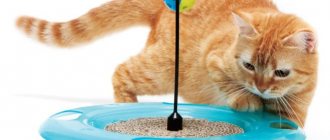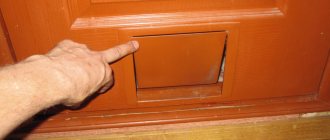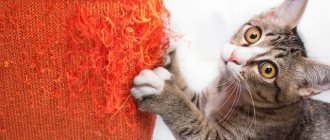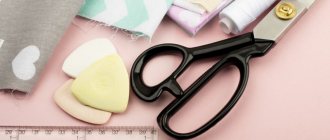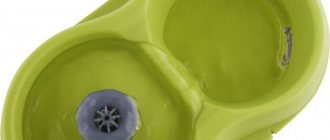Unlike most other cat breeds, Sphynx cats are not endowed with thick hair: they have a little hair on the tail, paws, and in the bridge of the nose. Therefore, it is more difficult for such pets to stay warm in the cold season, and they will definitely not give up their clothes.
Things can be made with your own hands from yarn, natural fabrics or various scrap materials (even from woolen socks). This way the owner will be able to warm the cat or take him for a walk in cool weather.
There are models of stylish dresses, suits and sweaters for adult cats and kittens that are easy to create if you follow the step-by-step instructions.
Material selection
Suits, sweaters and other things look good on hairless cats. To prevent animal skin from being injured, it is better to choose material that is not prone to accumulating static electricity. You can select the fabric as follows: wash the cut with a detergent without a strong odor, then dry it and place it on the cat bed.
If the cat sleeps on the canvas, it is suitable for sewing clothes.
Choosing yarn
To begin with, you should pay attention to the choice of yarn, which is purchased in specialized stores. Often, knitting experts work here, so they can advise you on the choice. Otherwise, give preference to acrylic, wool mixed with acrylic (50/50) or cotton - today there is a huge amount of cotton yarn, which, unlike the usual thin and stiff thread, is soft and retains heat.
You should not take angora, mohair or yarn with lurex for your first experiment. It is also not recommended to choose 100% wool, as there will be many problems with it - the wool shrinks, so you may make a mistake in calculating the size. Beforehand, the wool, while still in skeins, is soaked in warm water and dried on a warm radiator or in another warm place - this gives full shrinkage to the skein, so you can knit taking into account the natural dimensions of the model.
How to take measurements
The seamstress begins drawing up a pattern of clothing for a cat by taking measurements with a centimeter.
To make a life-size drawing, several parameters are measured:
- ОШ – circumference of the lower part of the neck;
- OG - chest circumference under the front legs;
- length - the distance from the base of the tail to the place where the neck begins.
If the item has a collar or sleeves (for example, overalls for a cat), additional measurements are taken. To do this, measure the length of the cervical region (from the very base to the ears), the girth of the torso (lower abdomen), and the hind and front legs (the widest part). When a pattern is created, it is made up with full dimensions, and the girth values are divided in half.
Sweater with a pattern
You can knit a gorgeous sweater with a pattern for your pet. It will be more complicated than the previous one, but it will look very interesting. It’s up to you to decide which sweater to choose.
For this sweater we will need:
- knitting needles number 3.5
- yarn 100 grams (light and dark) wool or 50/50 with acrylic
- needle
Knitting density 16 p. / 22 rows = 10/10 cm. Cast on 48 loops with blue thread and knit with a 2/2 elastic band. Switch to a white thread and knit 5 cm in stockinette stitch. Next, start knitting the pattern according to the pattern:
Scheme
At the same time, knit the holes for the paws: knit 7. loops, cast off 6 loops, knit 22. loops, close 6 loops. 7 persons. loops Knit the resulting 3 parts separately for the next 5 centimeters, then connect them by casting 6 loops above the closed loops. After 20 centimeters from the neck, start decreasing (3 times 3 loops on both sides). Close off the remaining stitches after finishing the pattern. Along the edges of the holes for the cat's paws, cast on 20 loops with a dark thread and tie 4 centimeters with a 2/2 elastic band. The sweater is ready.
Patterns + step-by-step instructions
Dress
To make a dress for a cat with your own hands, all you need to do is find a pattern and materials. In fact, it is an ordinary sleeveless vest, which is made according to a simple sketch.
Slots are made in the fabric for the paws, the edges are overcast and stitched. The fasteners are sewn on the back. This could be a zipper, ties or Velcro. A skirt with flounces is attached to the vest (they can also be attached to the sleeves).
Any decorations will do, as long as they are safe for the animal (bows, ribbons, ruffles, lace or frill).
Overalls
Overalls are stylish clothes for a cat that will keep him warm and comfortable. The overalls are sewn in layers: raincoat material is used for the top, fleece or knitwear is used for the lining.
The pattern consists of several elements: the left, right side and a wedge that is sewn between the front legs. The cuttings are placed on a fabric sheet, outlined, cut out taking into account allowances, pinned and tried on the cat. Well-fitted parts are connected.
How to sew an item? First, the upper and lower parts of the suit are fastened together. The lines on the sides and in the shoulder part are sewn with a zigzag seam. Afterwards the edges are processed. The last step is to sew on the clasp and accessories (this could be pockets, stripes and other decorations).
This type of clothing for Sphynx cats can be complemented with a hood to protect the animal from moisture and precipitation during a walk.
T-shirt
In the summer, it is advisable to protect the delicate skin of sphinxes from ultraviolet rays. To do this, you can sew a T-shirt from light fabric.
They take a schematic drawing as a basis, print it out and apply it to thin knitwear.
How to sew clothes for a pet? Step-by-step instruction:
- First, measure the length of the T-shirt. The back is folded in 2 layers, cut out, and a few centimeters are added so that the item does not restrict movement.
- Next, fold the two edges together and sew the parts together. Before stitching, the parts are fastened with pins.
The neckline and bottom do not need to be processed if the fabric does not fray.
Pajamas
Pajamas are comfortable indoor clothing for Sphynx cats who do not have fur. They will sleep comfortably in it. Fleece or flannel are suitable materials.
Before sewing clothes for a cat from your own fabrics, it is worth transferring the sketch onto the canvas. Then the holes for the legs are cut out and the armholes are processed.
Then loops are made and buttons are sewn on. The stitches are overlapped and processed in a zigzag pattern so that the folded ends do not press on the skin while sleeping.
The tuxedo
Sewing a tuxedo is much more difficult than other clothes for the Sphynx, for example, a blouse. It is better for beginners not to take on such work. This will require the ability to cut and perform complex finishing. Therefore, it is better to knit a tuxedo on knitting needles.
It is knitted in the same way as a sweater. At the same time, the length of the item is adjusted, since the front should be longer than the back. The butterfly can be black or brighter, such as red or burgundy.
Airy skirt
These hand-sewn clothes for the Sphynx are great for walks, holidays and photo shoots with the cat. Often at exhibitions, animals are presented in front of judges in stylish outfits.
Airy skirts are a good example of such things. They are made from tulle and satin ribbons. To make a lush tutu, you don’t need a drawing. Before sewing, measure the “waist” and add 10 cm to the resulting figure.
The ribbon is cut to this length. Next, the tulle is cut into strips 2 cm wide. The length indicator should be equal to the expected length of the pack, this value should be multiplied by 2. Then the tulle strips should be folded in half and loosely tied onto a ribbon in knots.
The fullness of the skirt depends on how tightly the material is knitted. To add volume, the length of the stripes varies. The tutu is tried on, and the ends of the ribbon are tied on the cat’s back.
Vest without pattern
To make a vest for cats with your own hands, you don’t need schematic drawings. To make the thing, you will need an ordinary sweater. How to make a vest (step by step instructions):
- Cut off the sleeve and place it on the table so that the seam is at the bottom and the fold is at the top.
- The collar will become the bottom of the vest. This part needs to be trimmed: the back will be longer and the front will be shorter. After this, folds are made or a ribbon is sewn on. In this case, the seam is located in the front.
- The place where the elastic is on the sleeve should correspond to the collar.
- The location of each armhole is determined as follows: a sleeve is applied to the cat, and then oval-shaped slits are made and processed along the edges.
Insulated model for walking
For a knitted sweater, you can also use a simple pattern to work with knitting needles and natural wool yarn (such as angora).
The diameter of the knitting needles is determined by the thickness of the threads. Before knitting, it is advisable to soak the yarn in water with a powder with a slight odor and hang it to dry in the fresh air.
To make sleeves on both sides of the knitted fabric, you need to add 18 loops, then knit about 10 cm (depending on the cat’s parameters) and close the 21st loop in the middle. For the next row, make another 28 over the closed loops and knit 10 cm in stockinette stitch. Then you will need to close 18 stitches on both sides. After knitting 10 cm, make an elastic band (its height is 3 cm) and close off the loops that remain. When everything is ready, start knitting the gate.
For those who are looking for easy, quick and budget-friendly ways to solve problems, clothes for the Sphinx can be made from socks. To do this, buy models without heels or look for not very worn pieces in your wardrobe, cut off the required length, then cut out the neckline and armhole (they can be additionally crocheted). Such clothes for the sphinx do not require a pattern - a schematic explanation is enough. Then the workpiece is sewn along the shoulder line. To prevent the resulting sweater or vest from riding up, two ribbons are tied to the bottom and the cat’s legs are threaded through them.
Pros and cons of knitted clothes
For dog owners who are familiar with knitting needles and also know how and love to knit, knitting a warm item for the cold season for their pet is a pleasure. Let's list the advantages of hand-made knitted clothes:
- Hand-knitted clothes are always fashionable.
- This will cost much less than store-bought pet clothing.
- No need to run around the shops looking for the right size, color, style.
- Knitted clothes will be made in a single copy.
- The clothes will be tailored exactly to size, that is, made to order: the chosen model, knitting pattern, length of the product, accessories - everything will satisfy exactly your wishes.
- From one skein of yarn you can knit not only a sweater or blouse, but also other accessories (hat, beret, scarf).
- In this outfit, your pet will stand out among others.
There are also disadvantages, but they are few and can be easily eliminated:
- Hand-knitted wool products stretch over time. This is very easy to fix by adding a simple thread to the knitting or buying yarn with a small percentage of artificial fiber.
- When worn and washed, “pillings” form on clothes. But they can be easily removed using a safety razor or a special device.
So, there are some advantages, it’s time to start choosing yarn.
Other patterns for sphinxes
Preparatory stage for sewing
To make a beautiful outfit for your pet with your own hands, you need to choose not only the type of clothing, but also the material. Both cases have their own nuances.
Choosing an outfit type
The choice of type of clothing directly depends on the purpose it serves, as well as on the season. For summer, you should choose T-shirts or a vest; for spring/autumn, a sweater, vest and light jacket are suitable, and for winter, a warm winter jumpsuit.
Fabric selection
The choice of material must be made based on the following criteria:
- purpose: everyday wear, at exhibitions, protection from dirt;
- season: summer, autumn and winter things;
- characteristics of the breed.
Based on these parameters, the requirements for the fabric are determined: wear resistance, moisture resistance, ease of cleaning, heat retention, fading in the sun.
Regardless of who will wear the clothes (kitten, cat or cat), it should be sewn or knitted from natural materials. Otherwise, there is a risk of developing allergies and dermatitis.
Most often, things for cats are made from viscose, cotton, linen, wool and synthetics. There are mixed models, the creation of which uses several types of materials at once. Each material has its own advantages and disadvantages. Therefore, carefully read the description of the selected fabrics.
What tools are needed?
If you need to sew a suit or any other type of clothing, then you will need a needle and thread and scissors. A sewing machine will help speed up the work process and make it better. If knitting will be used, then knitting needles and a hook are needed.
How to take measurements
To knit or sew, you need to take measurements of the animal. A knitted or sewn item of clothing is made to the same measurements. Therefore, it is enough to measure your pet correctly once.
The following quantities are required for operation:
- neck girth;
- back length (from the neck to the beginning of the tail);
- body girth. Measured just behind the forelimbs.
Other measurements are additional (for example, the distance between the paws). They arise if you need to sew a special suit. For standard outfits, these three measurements are quite enough.
When measuring the size of an animal, there is no need to leave extra centimeters in reserve. All measurements are carried out with the same centimeter, which during the process of taking measurements is in a free, and not in a tense, position. The result will be a small reserve, which will be enough for seams.
Pipe
So, what kind of design is this? This cat toy is a type of educational toy; it is a closed tube with holes the size of tennis balls. There are several of the same balls inside. The cat enjoys playing with them, rolling them around and trying to catch them out of the pipe.
Making a toy
You need four plastic sewer pipes, more precisely, pipe corners with a diameter of about 20 cm, as well as a flexible plastic tube (cambric type) to secure the cut holes and improve them.
Wrap two or three turns of electrical tape around the narrower edge of the pipe. Cut two holes in each corner. We connect the pipes, tightly fitting each other into a single structure.
On the cambric we make a cut lengthwise and tighten each hole, we get holes that are safe for the cat, into which you can climb with your paw and play.
You can also put crumpled paper candy wrappers into the toy; tailed pets play with them with pleasure. True, you will have to collect garbage around the apartment more often. Such a toy for a cat can be bought ready-made in a store, but its cost will be more than 10 times more expensive than one made by yourself.
Homemade cat toy. Cheap and easy homemade cat toy
A little about the herb catnip (catnip)
Why do most cats love catnip grass so much? Veterinarians say that catnip is a cat's cure for stress. Now many products are produced for cats using this plant: various sticks, balls, toys. There are even drops that are used to drip onto the scratching post - this is how the cat gets used to sharpening its claws and not damaging the furniture.
If the cat has no appetite, catnip is recommended as a food supplement. Add a pinch of dried or fresh herbs. Catnip is also an anthelmintic. Catnip is sold at any pet store; you can plant it at home in a pot. At the same time, you need to make sure that the cat does not eat it all at once, and there is no doubt that he will like it.
On video: why cats love catnip.
Watch this video on YouTube
Vest
Before you begin, measure your cat's waist circumference. The waist circumference is indicated on the pattern with the letter T.
If you choose wool for knitting, then opt for soft wool intended for children. You need about 50 gr. Knitting starts from the back and goes in one piece. First there is a 3 cm elastic band, then there is an armhole (by any method). We close the armhole loops on one side and knit to the end of the row. At the end, turning the work, we do the same and continue knitting to the neckline. To knit it, we make one shoulder, close the neckline by 5 cm and continue knitting for another 3 cm. We cast on loops for a 5 cm neckline and combine 2 shoulders.
Next we knit the front until the end of the work, finishing with 3 cm of elastic. Sew the side seams. We tie the neckline and armhole with a 2 cm elastic band.
Source
Family site for everyone
Of course, the Egyptian landmark does not need clothes - he is already warm, but the seals of the same name get very cold in their fur. To prevent the purebred cat from freezing, we will knit a sweater for the sphinx - warm, comfortable and beautiful, to match a royal person - a beauty. A woolen sweater is knitted easily, mainly with stockinette knitting needles: even an inexperienced knitter can master its creation using a step-by-step master class.
Mice have a sweet tooth
They say that mice love cheese more than anything in the world. But these mice are special. They have a sweet tooth and prefer candy, cakes and sugar. We advise you to keep an eye on them: in search of something tasty, they can climb everywhere. For example, you take out a box of eclairs, open the lid, and there are these little cheats sitting there.
You will need:
- Pink yarn (57% wool, 33% polyester, 10% cashmere)
- Green yarn (57% wool, 33% polyester, 10% cashmere)
- Yellow yarn (100% wool)
- A piece of white felt
- White floss threads
- Crochet hook No. 4
- Black buttons
- cotton wool
Accepted abbreviations
- air n. - air loops
- Art. without n. - single crochet
- 2 tbsp. without n. together - two single crochets together
- rep. - repeat
- ps. - half-column
- n. - loop or loops
Torso
Dial 2 air. P.
1st round: 6 tbsp. without n. on the second air. p. from the hook.
2nd round row: 2 tbsp. without n. on each stitch (12 stitches in total in a row).
3rd round: *1 tbsp. without n. on the next p., 2 tbsp. without n. on the next paragraph, repeat. from * to the end (only 18 stitches in a row).
4th round row: *1 tbsp. without n. on the next 2 p., 2 tbsp. without n. on the next paragraph, repeat. from * to the end (only 24 stitches in a row).
5th round row: *1 tbsp. without n. on the next 3 p., 2 tbsp. without n. on the next paragraph, repeat. from * to the end (only 30 stitches in a row).
6th round: *1 tbsp. without n. on the next 4 p., 2 tbsp. without n. on the next paragraph, repeat. from * to the end (only 36 stitches in a row).
Rounds 7–14: 1 tbsp. without n. on each p. 15th circular row: * 1 tbsp. without n. on the next 4 p., 2 tbsp. together, rep. from * to the end (only 30 stitches in a row).
16th round row: *1 tbsp. without n. on the next 3 p., 2 tbsp. without n. together, rep. from * to the end
(only 24 stitches in a row).
17th circular row: 1 tbsp. without n. on every point
18th round row: *1 tbsp. without n. on the next 2 p., 2 tbsp. without n. together, rep. from * to the end (only 18 stitches in a row).
19th circular row: 1 tbsp. without n. on every point
20th round: *1 tbsp. without n. on the next p., 2 tbsp. without n. together, rep. from * to the end (only 12 stitches in a row).
Sew on the eye buttons. Stuff the torso with cotton wool.
Rounds 21–22: 1 tbsp. without n. on every point
23rd round: *skip 1 p., 1 tbsp. without n. on the next paragraph, repeat. from * until the hole closes.
Ears (2 parts)
Dial 2 air. P.
1st round: 6 tbsp. without n. on the second stitch from the hook.
2nd round row: 2 tbsp. without n. on each stitch (12 stitches in total in a row).
3rd round: 1 tbsp. without n. on every point
Fasten the thread. Sew the ears to the head.
Tail
Dial 20 air. p., turn, ps. on each air P.
Pin the tail to the body with pins and sew it on.
DIY toys for dogs – bone
- white yarn - 20 grams (100% acrylic);
- hook No. 3;
- padding polyester for stuffing.
The base of the bone. Cast on a chain of three air loops and enclose it in a ring. In the 1st row, knit seven single crochets in the center of the ring, in the 2nd and 3rd rows, make seven increases, from the 4th to 7th rows, knit single crochets, from the 8th to 14th rows, make one decrease, from the 15th to 20th rows, knit single crochets. , from the 21st to the 27th rows, make one increase per row, in the 28th row, make seven decreases. Fill the resulting base of the bone with padding polyester. In the 29th row, knit single crochets, make seven decreases. Pull all the loops.
Side parts of the bone (four pieces). Cast on a chain of three air loops and enclose it in a ring. In the 1st row, knit seven single crochets in the center of the ring, in the 2nd and 3rd rows, make seven increases, from the 4th to 7th rows, knit single crochets. Fill the resulting balls with padding polyester and sew to the base.

